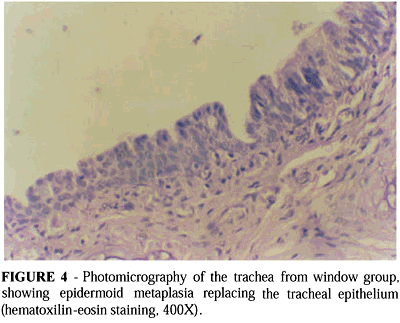PURPOSE: To compare morphologically three different types of tracheotomy in growing rats, applying microsurgical technique. METHODS: EPM-1 Wistar growing rats (n=57) weighing 88gm and aged 35 days were randomized in four groups, according tracheotomy incision type (longitudinal, transverse and tracheal segment excision), and sham group. Following intramuscular anesthesia with ketamine and xylazine, the trachea was exposed and incised, according to the group, and a hand-made endotracheal cannula was inserted into the organ, under sterile conditions. This cannula was removed after 7 days, and animals have been sacrificed 30 days later. Tracheas samples were submitted to histological study, stained by hematoxylin-eosin and Masson trichrome, evaluating fibrosis, inflammatory infiltrate and epidermoid metaplasia. RESULTS: There was more frequency of inflammatory infiltrate at the tracheal epithelium in the tracheal segment excision group (87%) compared to the longitudinal (40%) and transverse (36%) incision groups (p=0.009). Evaluating epidermoid metaplasia, tracheal segment excision and the longitudinal groups presented 33% and 40%, respectively, compared to 0% of the transverse group (p=0.03). Concerning to fibrosis, in a global comparison (p=0.1) among the three groups there was no difference, however, compared to the longitudinal group the transverse group showed lower level of fibrosis (p=0.04). Sham group did not present any relevant morphologic alterations and it was used as reference pattern. CONCLUSION: Taken together, our data show that tracheal segment excision promotes more epithelium aggression and transverse tracheal incision shows less morphologic alterations.
Tracheotomy; Models, animal; Rats,Wistar; Growing





